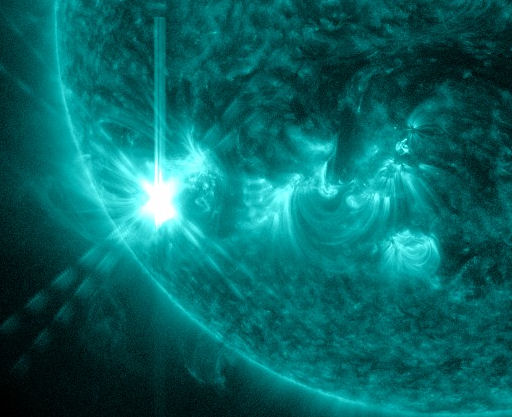GEOMAGNETIC STORM WARNING: NOAA forecasters estimate a 45% chance of polar geomagnetic storms on July 29-30 in response to a high-speed solar wind stream buffeting Earth's magnetic field. Even stronger storming could occur on July 31st when a CME associated with yesterday's M6-flare arrives. High-latitude sky watchers should be alert for auroras for the next three nights. Aurora alerts: text, voice.
SOLAR ACTIVITY PICKS UP: Sunspot AR1532 is crackling with M-class solar flares. The latest, an M6-class eruption on July 28th (2056 UT), produced a bright flash of extreme ultraviolet radiation, shown here in a snapshot from the Solar Dynamics Observatory:
Update: Contrary to earlier reports, this explosion did produce a CME and the cloud is heading for Earth. According to a forecast track prepared by analysts at the Goddard Space Weather Lab, the CME will reach our planet on July 31st at 1500 UT (+/- 7 hours). Weak to moderate geomagnetic storms are possible when the cloud arrives. Solar flare alerts: text, voice.
METEOR ACTIVITY: Last night, NASA's All Sky Fireball Network detected 17 Venus-bright meteors. The orbits of the meteoroids, color-coded by velocity, are shown in the diagram below. Earth's location is marked by a red starburst:
The green orbits correspond to Comet 96P/Machholz, source of the annual delta Aquarid meteor shower. Although this is a minor shower, it is fraught with interest. Some researchers believe that 96P/Machholz came from another star system. Every delta Aquarid that disintegrates in the night sky could be depositing material from across the galaxy into Earth's upper atmosphere.
Forecasters expect as many as 15 delta Aquarids per hour when the shower peaks on July 28th and 29th. The best time to look, no matter where you live, is during the dark hours before sunrise on Saturday and Sunday when the moon has set and the constellation Aquarius is relatively high in the sky.
Blue orbits correspond mainly to Perseids. The Perseid meteor shower doesn't peak until August 12-13, but Earth is already in the outskirts of the debris zone of the parent comet, 109P/Swift-Tuttle. By mid-August, rates could exceed 100 meteors per hour. The show, in other words, is just getting started.

![]()
Solar wind
speed: 396.5 km/sec
density: 1.2 protons/cm3
explanation | more data
Updated: Today at 1525 UT
![]()
X-ray Solar Flares
6-hr max: C3 1203 UT Jul29
24-hr: M2 0622 UT Jul29
explanation | more data
Updated: Today at: 1500 UT
![]()
![]()
![]()
Daily Sun: 29 Jul 12
![]()
![]()
Sunspot AR1532 poses a growing threat for M-class solar flares. Credit: SDO/HMI
![]()
![]()
![]()
Sunspot number: 108
What is the sunspot number?
Updated 29 Jul 2012
Spotless Days
Current Stretch: 0 days
2012 total: 0 days (0%)
2011 total: 2 days (<1%)
2010 total: 51 days (14%)
2009 total: 260 days (71%)
Since 2004: 821 days
Typical Solar Min: 486 days
Updated 29 Jul 2012
The Radio Sun
10.7 cm flux: 123 sfu
explanation | more data
Updated 29 Jul 2012
![]()
![]()
![]()
Current Auroral Oval:
![]()
Switch to: Europe, USA, New Zealand, Antarctica
Credit: NOAA/POES
![]()
![]()
![]()
Planetary K-index
Now: Kp= 1 quiet
24-hr max: Kp= 4 unsettled
explanation | more data
![]()
Interplanetary Mag. Field
Btotal: 8.6 nT
Bz: 7.2 nT north
explanation | more data
Updated: Today at 1526 UT
![]()
![]()
![]()
Coronal Holes: 29 Jul 12
![]()
![]()
A solar wind stream flowing from this coronal hole should reach Earth on July 29-30. Credit: SDO/AIA.
![]()
Got clouds? Try listening to meteor radar echoes on Space Weather Radio.






